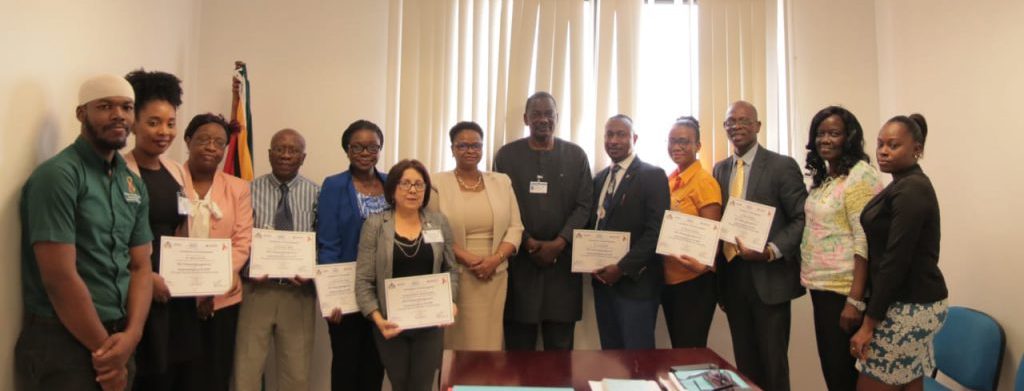
Ministry of Public Health (Guyana) is planning to introduce Pre-exposure prophylaxis (or PrEP)- seeks to have more ‘at-risk’ persons access HIV treatment through Public-Private Partnership
Image: Minister of Public Health, Hon. Volda Lawrence and UNAIDS Country Director for Guyana and Suriname, Dr Michael Gboun with participants of the HIV Clinical Management and Implementation of PrEP through a Public-Private Partnership Workshop
The Ministry of Public Health (Guyana) is planning to introduce Pre-exposure prophylaxis (or PrEP) as an HIV transmission countermeasure. This is a course of drugs taken pre-emptively against the spread of the disease, mainly targetted at vulnerable groups.
The target population in Guyana for HIV transmission prevention are sex workers with a 6.1% prevalence, men who have sex with men with a 4.9% HIV prevalence, and transgender people with an 8.4% prevalence. This is according to a UNAIDS survey conducted in 2016.
PrEP, or pre-exposure prophylaxis, is an HIV prevention method. People who do not have HIV can take PrEP to reduce their risk of getting HIV if they are exposed to the virus. Another countermeasure will see the government establishing a Public-Private Partnership with doctors within the private sector to whom patients will be referred for treatment.
USAID, UNAIDS and Pan American Health Organisation/World Health Organisation (PAHO/WHO) Office in Guyana along with the Ministry of Public Health hosted an HIV Clinical Management and Implementation of PrEP through a Public-Private Partnership Workshop. The three-day workshop ran from August 12 to 14, 2019.
Minister of Public Health, Hon. Volda Lawrence, who handed over certificates to participants of the workshop, noted that PrEP is a new venture of the ministry and is expected to be an effective measure in HIV prevention.
Essentially, the goal of these two new countermeasures is to ensure that full HIV prevention coverage is attained.
“Our goal is to ensure that we reach everyone everywhere. Guyana is a very small and unique country. As a result of that, it has become a stumbling block in terms of people accessing these services,” Minister Lawrence said.
She explained that due to discrimination, people are often reluctant to know their status and may spread the virus unknowingly. It is for this reason, after examining this fact with partners, the ministry thought it best to create ways in which persons can have confidence in HIV treatment and prevention services.
“The ministry stepping out in this particular venture in terms of creating another space allows persons to have their own choice of access to services. We believe it certainly will work towards the benefit of our people. It certainly will help us in terms of reaching persons and keeping persons in the system and utilising the services available.”
UNAIDS’ new Country Director for Guyana and Suriname, Dr Michael Gboun noted that moving in this direction is important since Guyana is on a road to improving access and achieving universal coverage in health care. “This partnership is important, and more so, when we are now testing a new model, PrEP, it calls for a little bit of close monitoring, closer relationships with patients,” Dr Gboun noted.
WHAT IS PANCAP?
PANCAP is a Caribbean regional partnership of governments, regional civil society organisations, regional institutions and organisations, bilateral and multilateral agencies and contributing donor partners established on 14 February 2001. PANCAP provides a structured and unified approach to the Caribbean’s response to the HIV epidemic, and coordinates the response through the Caribbean Regional Strategic Framework on HIV and AIDS to maximise efficient use of resources and increase impact, mobilise resources and build the capacity of partners.
What are the Global AIDS Strategy 2021–2026 targets and commitments?
If targets and commitments in the strategy are achieved:
- The number of people who newly acquire HIV will decrease from 1.7 million in 2019 to less than 370 000 by 2025
- The number of people dying from AIDS-related illnesses will decrease from 690 000 in 2019 to less than 250 000 in 2025.
- The goal of eliminating new HIV infections among children will see the number of new HIV infections drop from 150,000 in 2019 to less than 22,000 in 2025.
What are the 95-95-95 Targets for ending AIDS?
- 95% of People Living with HIV know their HIV status;
- 95% of people who know their status on treatment; and
- 95% of people on treatment with suppressed viral loads.
HELPFUL LINKS:
Global AIDS Strategy 2021–2026, End Inequalities, End AIDS
https://pancap.org/pancap-documents/global-aids-strategy-2021-2026-end-inequalities-end-aids/
Caribbean Regional Strategic Framework on HIV and AIDS (CRSF) 2019-2025
https://pancap.org/pancap-documents/caribbean-regional-strategic-framework-2019-2025/
